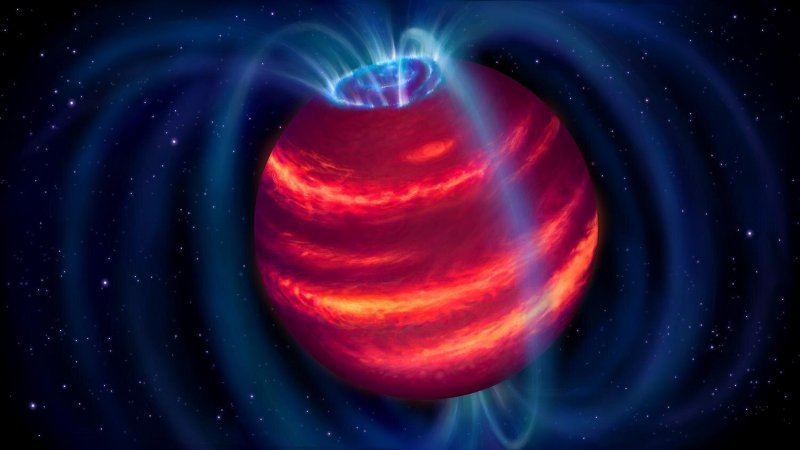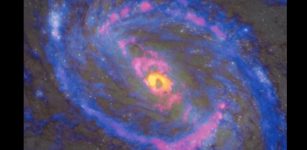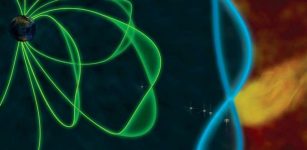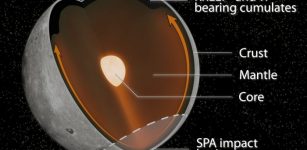Cold Faint “Super Planet” Discovered For The First Time Through Radio Telescope
Eddie Gonzales Jr. – MessageToEagle.com – For the first time, astronomers have used observations from a radio telescope and a pair of observatories on Maunakea to discover and characterize a cold brown dwarf, also known as a “super planet” or “failed star.”
The discovery, designated BDR J1750+3809, is the first substellar object detected through radio observations—until now, brown dwarfs have largely been found from infrared sky surveys.
 Artist’s impression of the discovery dubbed, Elegast. Credit: ASTRON / Danielle Futselaar
Artist’s impression of the discovery dubbed, Elegast. Credit: ASTRON / Danielle Futselaar
Dubbed “Elegast” by the discovery team, was first identified using data from the Low-Frequency Array (LOFAR) telescope, and then confirmed at the Maunakea (International Gemini Observatory and the NASA InfraRed Telescope) operated by the University of Hawai’i.
“This work opens a whole new method to finding the coldest objects floating in the Sun’s vicinity, which would otherwise be too faint to discover with the methods used for the past 25 years,” said astronomer Michael Liu and graduate student Zhoujian Zhang at the UH Institute for Astronomy (IfA) co-authored the paper published in The Astrophysical Journal Letters.
Brown dwarfs straddle the boundary between the largest planets and the smallest stars. Occasionally dubbed “failed stars,” brown dwarfs lack the mass to trigger hydrogen fusion in their cores. Instead they glow at infrared wavelengths with leftover heat from their formation, and possess gaseous atmospheres that resemble the gas-giant planets in our solar system more than they resemble any star.
The underlying process powering this radio emission is familiar, as it also occurs in the largest planet in the Solar System.
Jupiter’s powerful magnetic field accelerates charged particles such as electrons, which in turn produces radiation—in this case radio waves and aurorae.
The fact that brown dwarfs are radio emitters allowed the international collaboration of astronomers behind this result to develop a novel observing strategy. Radio emissions have previously been detected from only a handful of cold brown dwarfs, which were discovered and cataloged by infrared surveys before being observed with radio telescopes.
The team decided to use a sensitive radio telescope to discover cold, faint radio sources and then perform follow-up infrared observations with Maunakea telescopes to categorize them.
“We asked ourselves, ‘Why point our radio telescope at cataloged brown dwarfs?'” said Harish Vedantham, lead author of the study and astronomer at ASTRON in the Netherlands. “Let’s just make a large image of the sky and discover these objects directly in the radio.”
Among a variety of tell-tale radio signatures in their observations, the team had to distinguish potentially interesting sources from background galaxies. They focused on a special form of radio waves that were circularly polarized—a feature of light from stars, planets, and brown dwarfs, but not from background galaxies.
Having found a circularly polarized radio source, the team then turned to image archive from the Gemini-North Telescope, and the NASA IRTF to provide the measurements required to identify their discovery.
The team used SpeX to obtain a spectrum of BDR J1750+3809, which revealed the characteristic signature of methane in the atmosphere. Methane is the hallmark of the coolest brown dwarfs, and also abundant in the atmospheres of our solar system’s gas-giant planets.
“These observations really highlight the increased efficiency of SpeX following its NSF-funded upgrade with state-of-the-art infrared arrays and electronics in 2015,” said John Rayner, IRTF Director and astronomer at the UH IfA.
Written by Eddie Gonzales Jr. – MessageToEagle.com Staff










